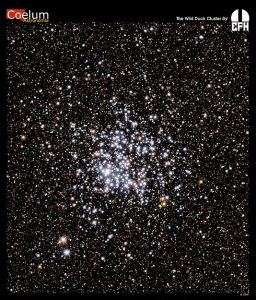The Ages of Stars
I have been searching for and studying aging stars in binary star systems within star clusters. For stars in an eclipsing binary system, we are often able to measure their characteristics (like mass and size) with high precision. The size of a rapidly expanding star can subsequently give us its precise age. I have been working to find such stars in clusters — groups of stars that were born at the same time — so that we can test our measured ages against other techniques in order to better understand the internal mechanisms that make a star work.
For perspective, dating of meteorites using radioactivity puts the Sun and solar system at about 4.57 billion years.
Some of our recent cluster targets:
M11/NGC 6705 (220 million years old)

Astronomy Picture of the Day
Reference: Bavarsad, E. A., Sandquist, E. L., Shetrone, M. D., & Orosz, J. A. 2016, Astrophysical Journal, 831, 48. Link
Praesepe/M44 (640 milion years old)
Reference: Morales, L. M., Sandquist, E. L., Schaefer, G. H., et al. 2022, Astronomical Journal, 164, 32. Link
NGC 6811 (1.1 billion years old) – a cluster observed by the Kepler spacecraft
Reference: Sandquist, E. L., Jessen-Hansen, J., Shetrone, M. D., et al. 2016, Astrophysical Journal, 831, 11. Link
NGC 752 (1.6 billion years old)
Reference: Sandquist, E. L., Buckner, A. J., Shetrone, M. D., et al. 2023, Astronomical Journal, 165, 6. Link
NGC 6819 (2.4 billion years old) – a cluster observed by the Kepler spacecraft
References: Brewer, L. N., Sandquist, E. L., Mathieu, R. D., et al. 2016, Astronomical Journal, 151, 66. Link
Jeffries, M. W., Jr., Sandquist, E. L., Mathieu, R. D., et al. 2013, Astronomical Journal, 146, 58. Link
Sandquist, E. L., Mathieu, R. D., Brogaard, K., et al. 2013, Astrophysical Journal, 762, 58. Link
NGC 7142 (3.6 billion years old) – pictured at top (credit: Tony Hallas)
Reference: Sandquist, E. L., Shetrone, M., Serio, A. W., & Orosz, J. 2013, Astronomical Journal, 146, 40. Link
M67/NGC 2682 (3.7 billion years old)
Reference: Sandquist, E. L., Latham, D. W., Mathieu, R. D., et al. 2021, Astronomical Journal, 161, 59. Link
